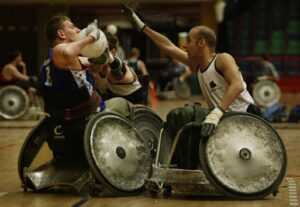
Paralympic Sport Origins
Paralympic sport has come a long way from its humble beginnings at the Stoke Mandeville spinal cord injury unit in England just after the Second World War. This small sporting event, which at the time used competition between those with similar injuries to assist the rehabilitation of wheelchair users, is now a worldwide phenomenon. The movement now boasts a 4-yearly event working in conjunction, and very much on a par, with the Olympic Games. In addition many of the individual sports have their own international sporting events governed by the IPC (International Paralympic Committee) and run separate international event calendars. Competitors in these events are often household names and on many occasions able bodied and para sports run events alongside each other. The transformation of disability sports has been amazing, as has its influence on the quality of the lives of disabled people in general over the same time frame.
However in more recent years, is the direction of movement for those involved in para sport the correct one? Is it time we had a serious, and perhaps difficult, conversation about who benefits and who doesn’t from how things have changed with Paralympic sport? Are we still helping those who the movement was set up to help? And while the success of the movement in general is a really good thing, do the inevitable commercial pressures of this success actually have some negative impacts on inclusion and participation of those with disabilities? There are a number of areas in relation to this that could be discussed, however I would like primarily to give my thoughts on what I see as the direction of travel of the Paralympic movement. Are we seeing those with more severe disabilities losing out to those with less severe disabilities? Is there enough representation for those who are much further from having fully working bodies than those who have smaller impairments and if so, why is this? I will move onto my thoughts around this subject in part 2 of this article but in part 1I think it is worth discussing another area – classification, to understand more about what is happening. Importantly I don’t want this article to be a criticism of the Paralympics and para sport itself, governing bodies within it or individuals (athletes or otherwise). What I do want to do is begin a discussion about where we think it should be going in the future. This discussion might be difficult to hear but I think it is one that ultimately needs to take place, and take place now.

Before I let you know about my thoughts on all this, a bit of background on me would probably help. I have a C5/6 incomplete spinal cord injury and I live in the UK. Over many years I have competed to a decent level in wheelchair rugby and wheelchair racing and I have also been involved in other disability sports. I can only speak from my personal experience and from knowledge gained from others I have met in that time. Although I have been selected to represent team GB in the past I want to make it clear I am not writing this out of frustration for not being selected for my national squad for any particular event – my performances were not where they needed to be in the world rankings for my classification to achieve selection and I understand that.
Classification adjustments and the knock-on affect
Classification is always going to be a difficult area and will always have controversy around it. There has been some controversy regarding Paralympic classification in recent times. The classification system has some parallels in able bodied sport such as weight categories in combat sports and Olympic weight lifting and is used similarly in Para Sport to increase fairness. It was designed to allow people of a similar physical ability to compete against others with roughly the same physical ability. It is not a perfect system and there will always be those who benefit from being at the top end of a particular classification bracket and also those who may find it harder as they find themselves in the lower end of that bracket. I have been participating in disability sport for over two decades now. I am by no means an expert in classification so all I aim to do here is bring up some topics for discussion around disability classification. I will begin with some of my own thoughts and experiences of classification in the sports I have played over the years.
My view is that in both wheelchair rugby and wheelchair track racing over the last few Paralympic games, those with more severe impairment have been squeezed out the bottom of the sports they love by different disability types and borderline classification calls gradually raising the bar of who they can actually compete with. My category in racing – T52 is a mixed disability classification in which athletes who exhibit similar working muscles groups and movement compete together. In recent years the classification boundary has moved a little which has allowed athletes with different disability types but who on the surface still exhibit similar physical ability to enter our category when they would previously have been in the categories above us. Many of these new athletes are great athletes, nice people and good friends of mine. It is not their fault that they have been categorised the way they have and on the surface they exhibit very similar muscle activity to others in this classification. However when you look more closely there are other differences that are important in addition to muscle strength which means things are not necessarily a level playing field. For example those with a higher level spinal cord injury (a neck injury rather than a back injury) cannot elevate their blood pressure and heart rate to the same extent as a non spinal cord injured athlete with similar impairment. There is a direct relationship between athletic performance and elevation of blood pressure and heart rate. An athlete with the same body function and fitness but who’s heart rate and blood pressure is restricted due to their disability type will not achieve the same output as one who is not restricted in this way. I understand that athletes of all disability types also need the opportunity to race in a category that is appropriate for their disability. My concern is the knock on effect of adding more and more athletes to the top end of classification boundaries and how this affects those sports and who can compete in them in the long term.

Which Paralympic Sport Athletes Suffer?
I believe this has also happened in wheelchair rugby. When I began playing wheelchair rugby it was a sport nearly exclusively played by those with spinal injuries. In fact it was invented by quadriplegic wheelchair users in Canada as they found it difficult to take part in wheelchair basketball due to their lack of hand function and strength. Classification for wheelchair rugby players ranges between 3.5 and 0.5 points and a team is made up of 4 players totalling no more than 8 points. When I was first classified as a wheelchair rugby player I began as a 3.0 point review player which later dropped to a 2.5 point player. If I was classified now I would most likely come out as a 2.0 pointer. The extent of my disability has not changed much in this time but the classification boundaries have slightly shifted. Many players who would previously have been considered “too able” to play are now playing as higher point players which has a knock on effect throughout the whole classification system. In many seemingly positive ways this makes the game look faster, more dynamic and exciting and adds to the diversity of which disability types can play the game but this also has negative consequences. These classification adjustments have meant that the previous high point players are now mid-point players, those mid-point players are now lower point players. The problem with this is that those who were previously the lower point players, the 1.0 and 0.5 pointers, the ones who struggle the most to find competitive sports to play, now struggle to compete at all. Where do they go, what sport do they play? This was a sport set up specifically for those who, through no fault of their own or lack of training, were unable to compete at basketball. Where do these dedicated athletes go in terms of sport when they are getting pushed out the bottom end of the sport that was designed for them?
I wanted to highlight some of the issues I have noticed in classification as it has implications for Paralympic sport in general. It’s not an obvious and rapid change and some may say that as disabled athletes train harder and techniques and equipment improve, this movement of classification boundaries will naturally shift slightly. However I disagree. I think it is more than this and I do believe it is a cause, or perhaps a symptom, of a trend in disability sport moving in this direction. In my mind the Paralympic movement was set up to give sport to those who could not play it with able bodied competitors. Those who had no chance to even play, yet alone compete with, able bodied athletes then had sports and organisations enabling them to do one of the major things they desired to do – compete, with others like them.
More about the knock on effect this has for the para sport movement in general in part 2.
Rob Smith
Wheelchair racer and disability sport athlete
CEO at the Active Hands Company
The post Does Paralympic sport benefit the right athletes? Part 1 of 2. appeared first on The Active Hands Company.